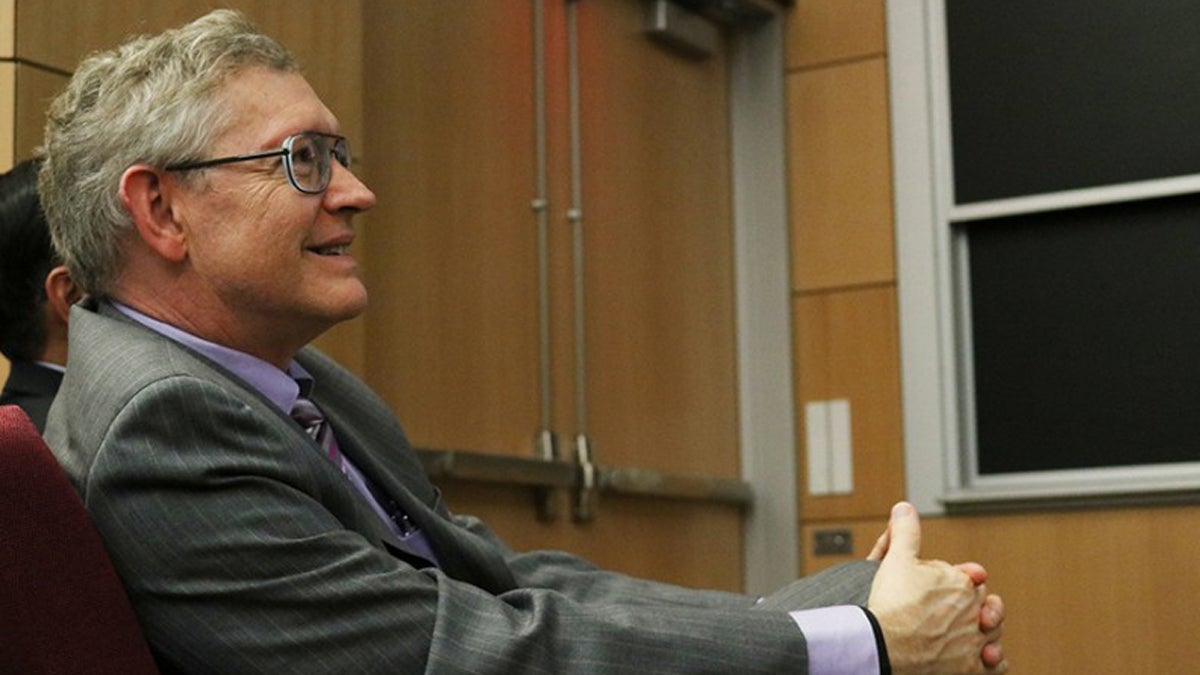Using tiny points of light to shatter limitations in microscopy
Listen
W.E Moerner was the first scientist to optically detect a single molecule. (Photo courtesy of Evan Easterling/The Temple News)
It was a trace on a computer screen, a quick blip. But a team of scientists led by W.E Moerner knew they had just seen a game changer.
Almost three decades ago, while working at IBM, the Stanford chemistry professor was the first scientist to optically detect a single molecule. It opened up a world of new possibilities.
“In typical experiments in the chemistry or physics labs, you measure a sample but you measure millions and billions of molecules all at the same time,” said Moerner, during a recent visit to Temple University. “You get one number, the mean, or the average, over all of those molecules. We remove that averaging, we can now measure a property for each molecule – and we can ask, are they the same, or are they different?”
Moerner offers a baseball analogy that he attributes to his former grad student Katherine Willets, who now teaches chemistry at Temple University.
If you only know the team batting average, you only know one number – but if you know batting averages player by player – you will have much better information – and you can observe that pitchers have low batting averages.
Moerner’s work overcame a barrier in regular microscopy – the limit of detail that’s achievable due to the wavelength of light.
“The problem has been, all along, the so-called refraction limit,” said Moerner.
“If we’re using visible light, it has a wave length of about 500 nanometers, and this limit means you can’t see detail finer than half that. So even if you bought the most expensive microscope possible, you couldn’t optically see any details finer than 250 nanometers. That’s huge compared to the objects inside cells, so images were fundamentally blurry.”
His method makes use of fluorescence in individual molecules.
“The way we do that is we treat them as tiny sources of light – and we image them at different times,” he explained. He says it’s a little bit like if you’re trying to see tree branches at night. If you took fireflies and placed them all along the branches of the tree, and let them blink on and off, you’d be able to find each of their positions easily. Taking images over time makes it possible to create a complete picture.
In 2014, Moerner won the Nobel prize in chemistry for his work in super resolution fluorescent microscopy – which has been changing a lot of fields including biology.
“We can now see structures that we couldn’t see before – especially in bacteria which are already very small,” said Moerner. “We can see fine structures, the positions of DNA – and pretty much all of cell biology needs to be redone using this new method to see more of what’s really present, rather than concluding things from the fuzzy images that we had before.”
Moerner says despite his hard work and big achievements, he’s always enjoyed activities outside of the realms of science.
“I’m one of these people who is a little bit more normal,” he said with a laugh.
“I like to spend time with my family, my wife, my son, and I didn’t give up those things. We had dinner together most nights. I think you can have more perspective and be more productive if you have a balanced life.”
Moerner loves singing and has been part of choirs and glee clubs as a tenor.
“I tend to believe that you don’t have to sacrifice everything – there are some people who do, and I used to think – ‘they are always going to be more productive than I am,’ but, hey, it worked out okay!
WHYY is your source for fact-based, in-depth journalism and information. As a nonprofit organization, we rely on financial support from readers like you. Please give today.




